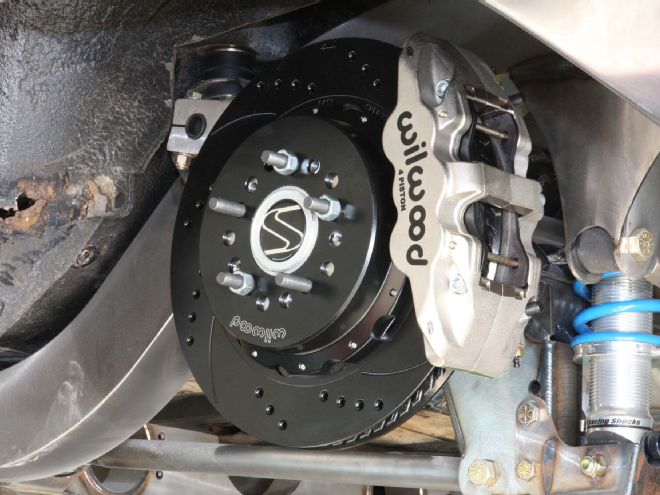
We often hear the subject of “the good old days” being debated by hot rodders. And while life back then may have been simpler, in terms of performance they were the dark ages. Those were the days when 1 hp per ci was a big deal and bringing a car to a halt was done with drum brakes—but by contemporary standards the “good old days” weren’t all that great.
Today horsepower numbers that were at one time inconceivable are easily achievable, and ARP/STREET RODDER ragtop proves the point. Our twin TorqStorm supercharged 427-inch small-block Ford made 648 hp at 6,000 in Westech’s dyno. A series of pulley swaps resulted in 15 pounds of boost, 790 hp, and an astonishing 692 lb-ft and there was still potential for more. But with that much power on tap in a car that tips the scales at over 3,800 pounds there is another important performance consideration and that is having the stopping power to match the go power.
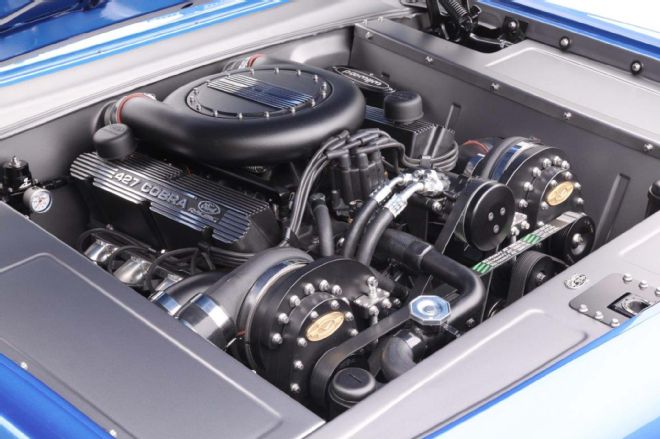 With the performance potential of a twin TorqStorm supercharged 427 Ford under its hood the ARP/STREET RODDER Road Tour car needed brakes to match.
With the performance potential of a twin TorqStorm supercharged 427 Ford under its hood the ARP/STREET RODDER Road Tour car needed brakes to match.
Discs for Drums
Certainly the drum brakes that were original equipment on our 1961 Ford Sunliner were not up to the task of bringing our revitalized ragtop to an abrupt stop. To cure that Hollywood Hot Rods equipped the Roadster Shop chassis with Wilwood disc brakes at all four corners.
While all brakes rely on friction to stop the car, friction creates heat, and heat is the enemy of brakes. As the friction surfaces become hotter the coefficient of friction between the two is reduced and the brakes lose effectiveness. The big advantage to disc brakes is the caliper only covers a small part of a disc brake’s friction surface, which leaves a large portion of the rotor exposed to air to promote cooling. With a drum brake most of the friction surface is in contact with the brake shoes, which leaves little surface area for cooling. Thanks to Wilwood there’s another advantage to disc brakes and that is they are available in sizes commensurate with the demands placed on them. Rotors up to 14 inches in diameter are available (the same size as the wheels that were original equipment on our Ford), and big calipers with up to six pistons can be fitted to bring even the fastest cars to a safe stop.
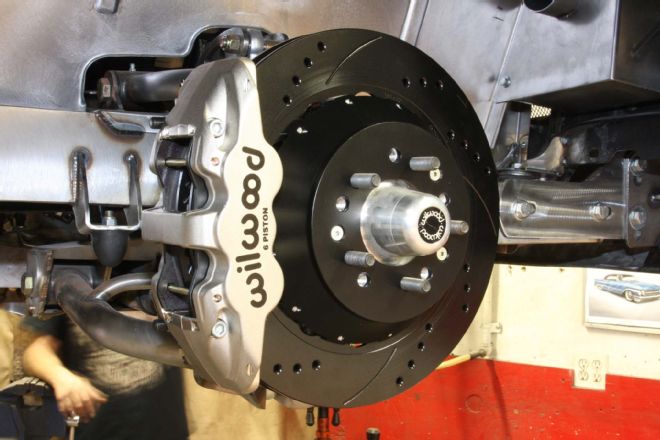 To bring our Ford to a halt the front end has been equipped with Wilwood six-piston calipers and ventilated, drilled, and slotted 14-inch rotors.
To bring our Ford to a halt the front end has been equipped with Wilwood six-piston calipers and ventilated, drilled, and slotted 14-inch rotors.
Calipers
Wilwood has a long list of innovative products including the Superlite 6 Piston SL6 calipers we used on the front of our Ford. The machined billet bodies of these calipers use six stainless steel pistons with what is referred to as a differential bore configuration. Developed from Wilwood’s racing involvement, it means that the piston sizes are staggered, in pairs, along the length of the caliper body. According to Wilwood “clamping pressure is proportionately distributed to provide balanced pad loading with even wear properties at all loads and temperatures. Pad life is extended and performance is measurably improved.” In the rear we used Superlite 4R calipers. Also made from billet aluminum, these four-piston calipers have the highest clamping efficiency and the lowest deflection of any caliper available.
To mount the front rotors Wilwood’s aluminum CNC machined hubs were used. They come complete with bearing races installed, new bearings, grease seals, screw-on billet aluminum hubcaps, and 1/2-20 RH grade-8 wheel studs
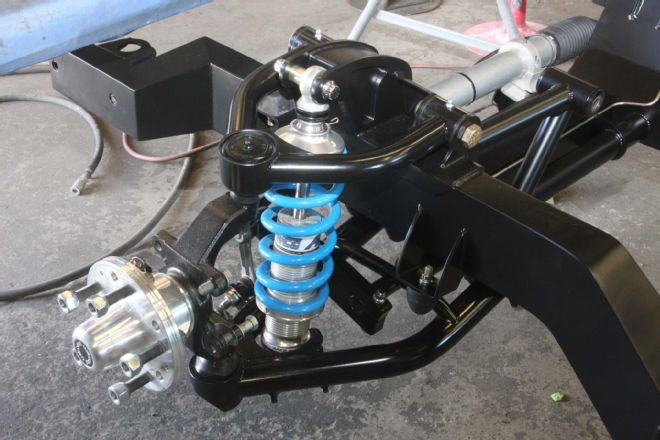 Here the Roadster Shops front suspension has been fitted with Wilwood’s aluminum hubs. The coilovers are from AFCO.
Here the Roadster Shops front suspension has been fitted with Wilwood’s aluminum hubs. The coilovers are from AFCO.
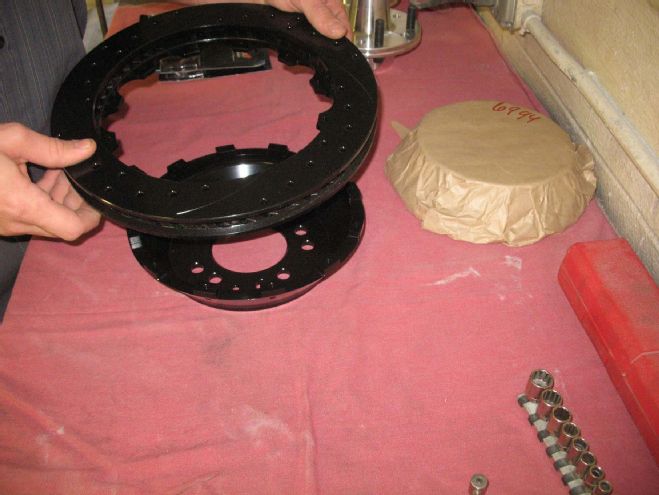 The Wilwood rotors are comprised of two parts, the disc and the hat.
The Wilwood rotors are comprised of two parts, the disc and the hat.
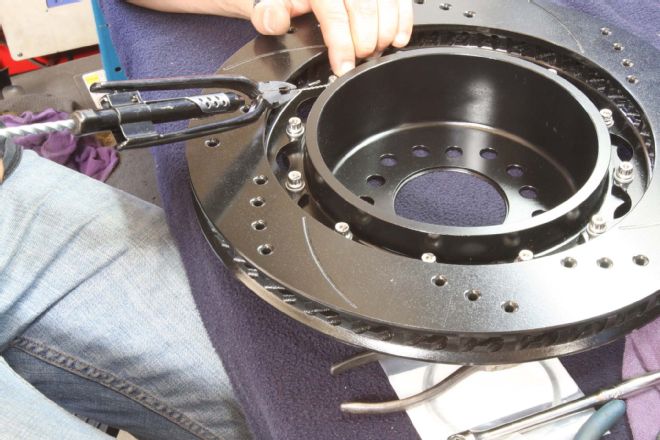 After bolting the disc onto the hat the attaching hardware is safety wired—this is the rear disc with the integral parking brake drum.
After bolting the disc onto the hat the attaching hardware is safety wired—this is the rear disc with the integral parking brake drum.
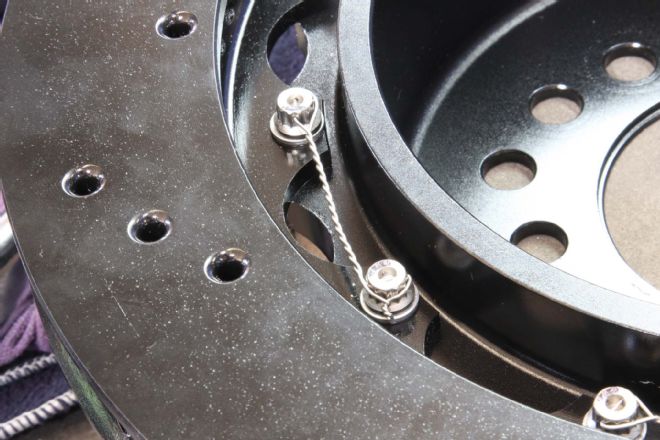 When properly installed the safety wire looks like this (thread locker is also used).
When properly installed the safety wire looks like this (thread locker is also used).
Radial Mounting
A unique feature found on the calipers we used is Wilwood’s radial mounting system. The caliper mounting brackets use precision shims to allow adjusting the caliper in two planes (closer or farther from the centerline of the spindle pin or axle on one plane—centering the pads over the rotor’s friction surface on the other).
Parking Brake
Although rear disc brakes offer a substantial improvement over drums, incorporating a parking brake does complicate the installation. While there are a number of methods incorporating a parking brake into rear disc brakes, such as calipers with built-in mechanisms to mechanically apply the brakes, small, separate mechanical calipers on the rear rotors or a disc on the pinion yoke, we prefer the internal shoe design Wilwood offers. The later is not only effective but it’s completely hidden inside the rotor hat for a clean look.
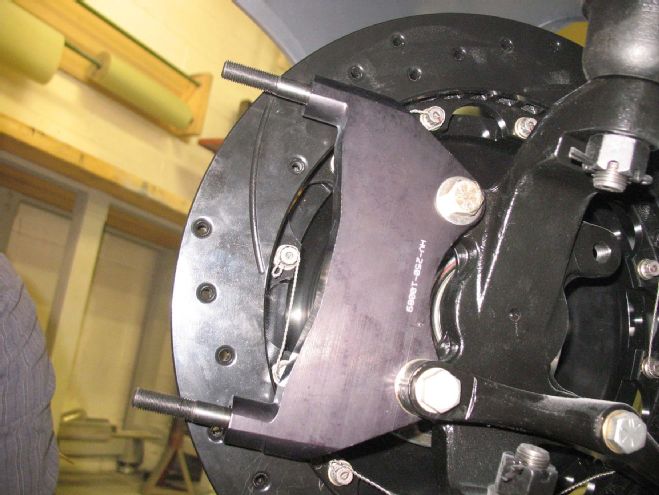 Wilwood’s radial mount for the front brakes allows the rotor to be placed precisely in relationship to the disc.
Wilwood’s radial mount for the front brakes allows the rotor to be placed precisely in relationship to the disc.
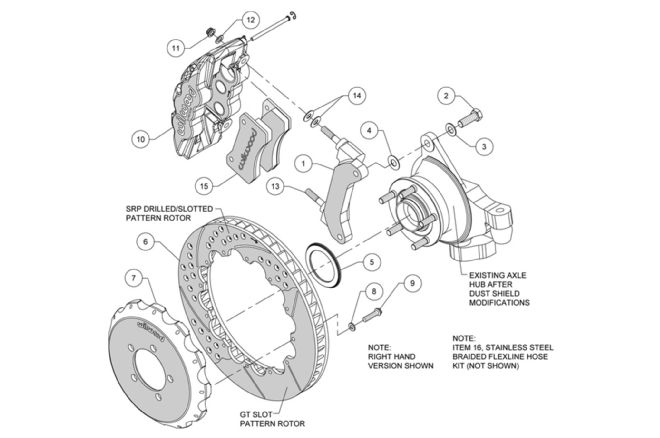 This exploded view shows all the typical parts of a Wilwood brake with a radial mount. Note the different sizes of the pistons visible in the caliper.
This exploded view shows all the typical parts of a Wilwood brake with a radial mount. Note the different sizes of the pistons visible in the caliper.
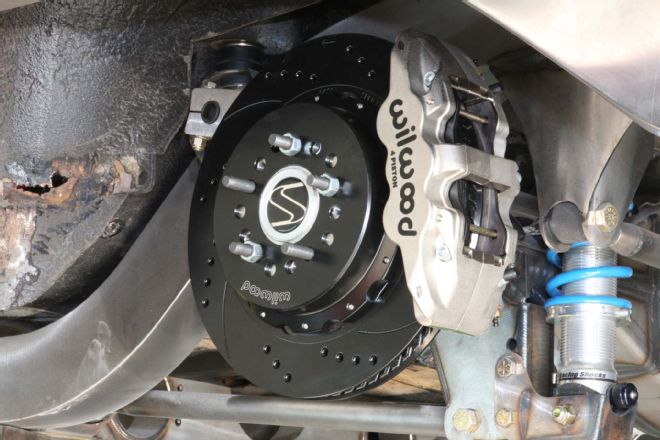 In the rear four-piston calipers with 12.88-inch discs are used.
In the rear four-piston calipers with 12.88-inch discs are used.
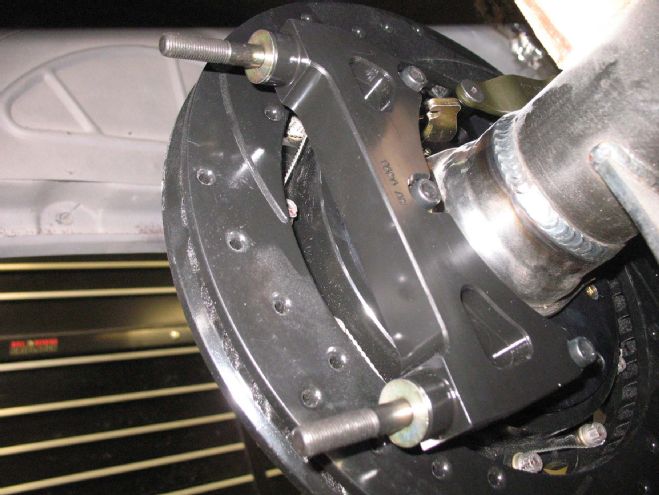 As in the front, radial caliper mounts are used. Note the shims that have been installed on the studs.
As in the front, radial caliper mounts are used. Note the shims that have been installed on the studs.
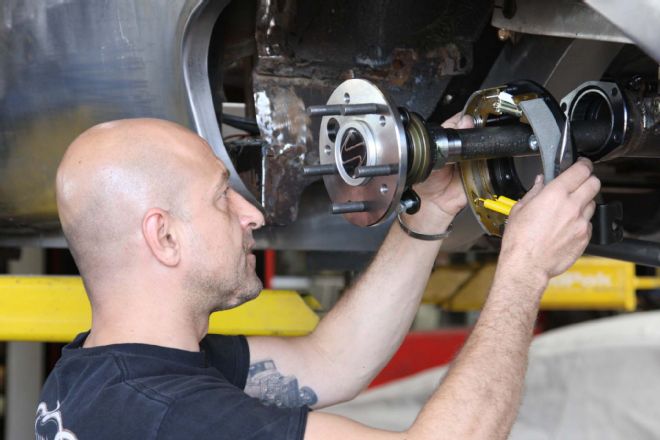 The parking brakes consist of mechanically activated internal expanding shoes.
The parking brakes consist of mechanically activated internal expanding shoes.
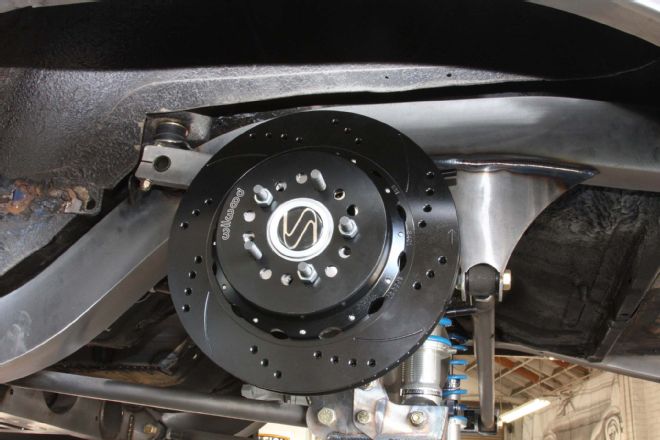 Wilwood’s combination hat and parking brake drum is compact and effective while hiding all the inner workings.
Wilwood’s combination hat and parking brake drum is compact and effective while hiding all the inner workings.
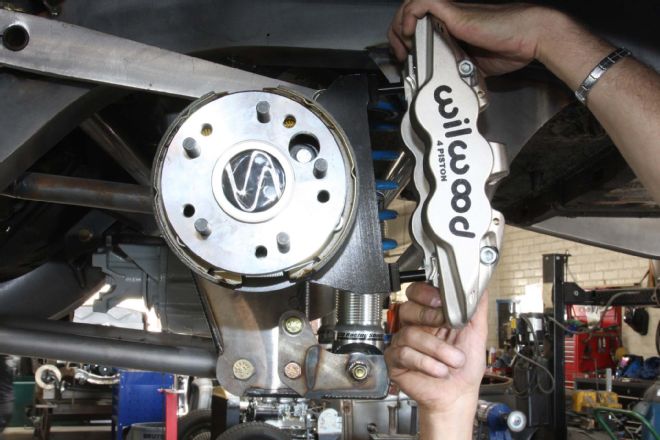 Here the rear calipers are given a testfit to check for wheel and chassis clearance.
Here the rear calipers are given a testfit to check for wheel and chassis clearance.
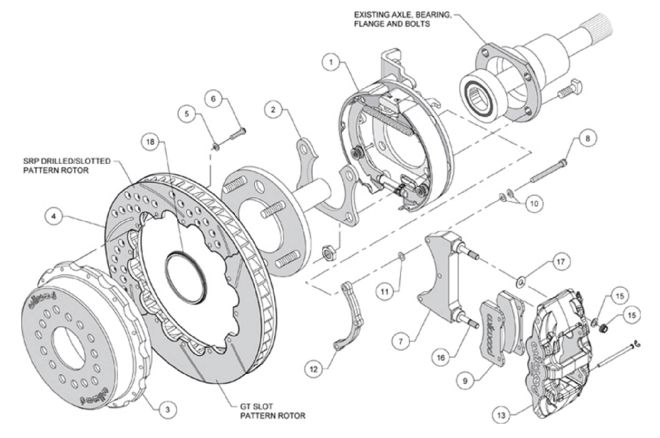 This exploded views shows all the components of the rear discs and the parking brake assembly.
This exploded views shows all the components of the rear discs and the parking brake assembly.
Master Cylinder
Master cylinder bore size is dependent on several variables, including how the master cylinder will be actuated—it may be manually or with the assistance of a booster. The next considerations are piston area of the master cylinder, the piston volume of the calipers, and the pedal ratio. While many think the opposite is true, a larger master cylinder bore produces more volume and a smaller master cylinder bore produces more pressure. To determine the appropriate master cylinder bore for your specific application, review Wilwood's Tech Tip Guide. For our application we used Wilwood’s 260-9439-BK tandem master cylinder. Fully machined from a high-pressure die-casting it has a total piston stroke of 1.10 inches and a 2:1 volume ratio between the primary and secondary chambers. They are available in 7/8-, 1-, or 1-1/8-inch bore sizes.
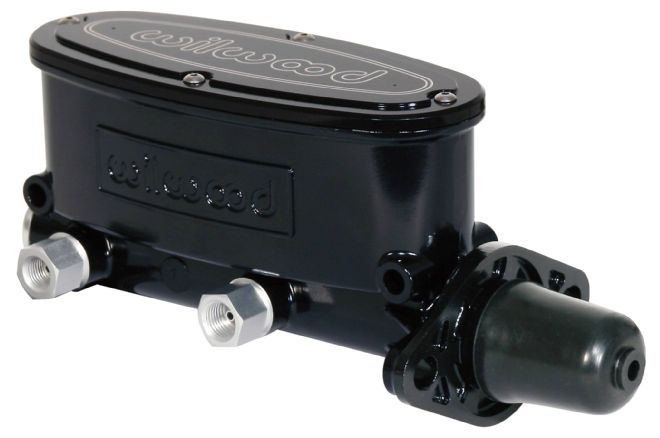 Wilwood’s aluminum master cylinder features dual outlets for right- or lefthand plumbing. It incorporates a slotted mounting flange to accommodate bolt centers between 3.22 to 3.40 inches and also features side mounting holes on 6.40-inch centers.
Wilwood’s aluminum master cylinder features dual outlets for right- or lefthand plumbing. It incorporates a slotted mounting flange to accommodate bolt centers between 3.22 to 3.40 inches and also features side mounting holes on 6.40-inch centers.
Before installing a master cylinder Wilwood advises bench bleeding to remove any air. The procedure is simple, the mounting flange of the master cylinder is carefully clamped in a vise then 3/8-inch/24-thread barbed fittings (they’re normally plastic and come in bench bleeding kits) are screwed into each of the pressure ports. Sections of clear plastic are attached to each fitting with the ends submerged in the reservoirs that have been filled with brake fluid. A Phillips head screwdriver (or other device that simulates a pushrod) is used to slowly stroke the piston until air bubbles coming out of the hoses.
Pedal Ratios
One of the ways stopping power is increased is with the mechanical advantage provided by the brake pedal. With a 1-inch master cylinder bore, a 100-pound push on a pedal having a 4:1 ratio, the force is 4x100=400 pounds. With a 100-pound push on the pedal with a 6:1 ratio, the force is 6x100=600 pounds.
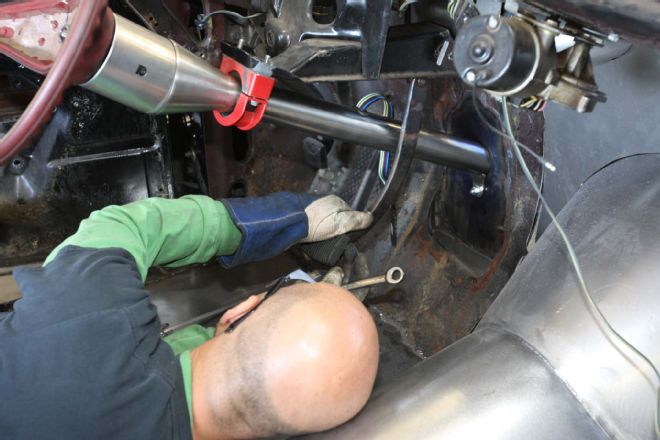 Brake pedal ratios are critical. For our application without a booster Hollywood Hot Rods retained the original Ford brake pedal.
Brake pedal ratios are critical. For our application without a booster Hollywood Hot Rods retained the original Ford brake pedal.
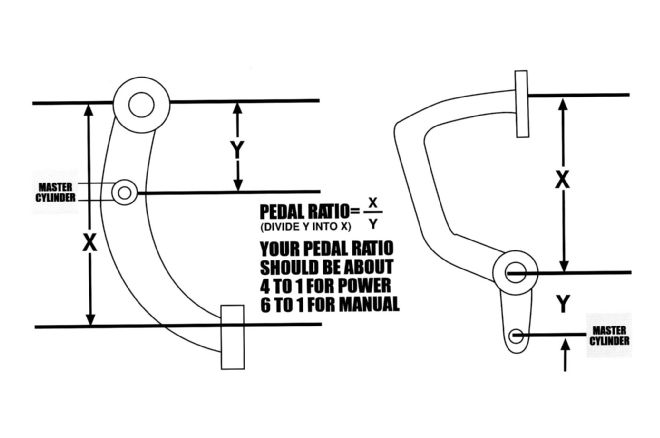 This is hot to figure brake pedal ratios for master cylinders on the firewall and below the floor.
This is hot to figure brake pedal ratios for master cylinders on the firewall and below the floor.
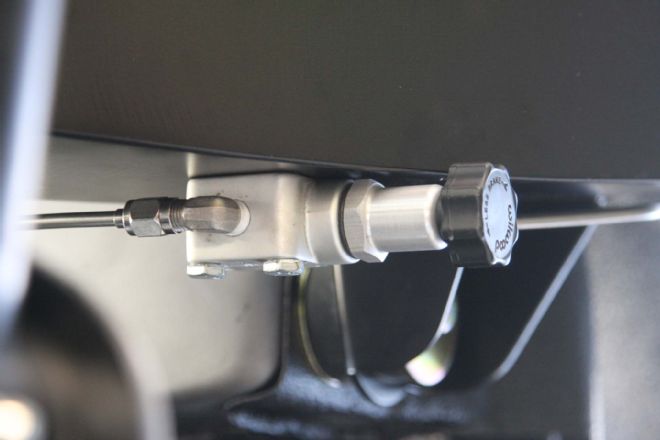 Our braking system includes a proportioning valve to adjust front to rear brake bias. Turning the knob counterclockwise reduces pressure to the rear to prevent them from locking up prematurely.
Our braking system includes a proportioning valve to adjust front to rear brake bias. Turning the knob counterclockwise reduces pressure to the rear to prevent them from locking up prematurely.
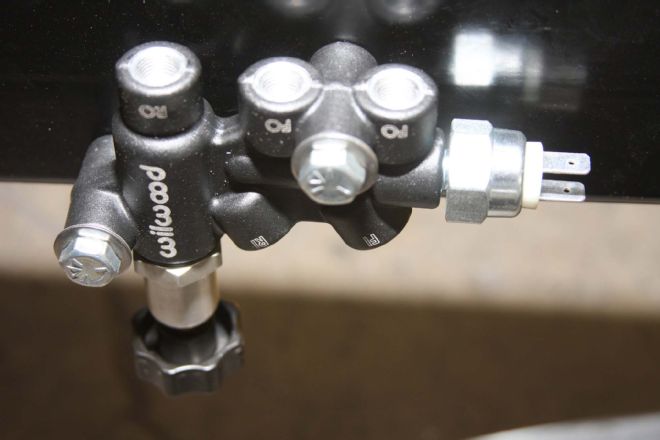 This proportioning valve also includes a hydraulic brake light switch.
This proportioning valve also includes a hydraulic brake light switch.
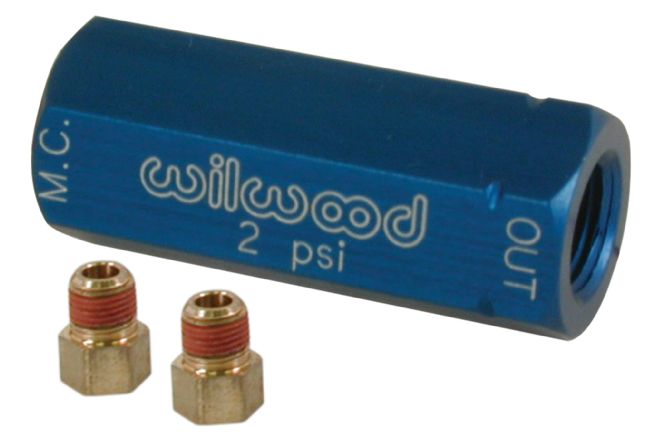 Residual pressure valves retain a minimum brake line pressure to help eliminate excessive pedal travel. The 2-pound valve is used in disc brake applications where the master cylinder is mounted below the horizontal plane; a 10-pound valve is used with drum brakes.
Residual pressure valves retain a minimum brake line pressure to help eliminate excessive pedal travel. The 2-pound valve is used in disc brake applications where the master cylinder is mounted below the horizontal plane; a 10-pound valve is used with drum brakes.
Brake Fluid
Brake fluid standards are established by the DOT (Department of Transportation) and essentially indicate the fluid’s boiling point. As the brake system heats up, brake fluids with low boiling points begin to vaporize and the pedal must travel further to apply the same amount of force on the brakes.
The most commonly used brake fluids are DOT 3, DOT 4, and DOT 5.1. All are glycol-based fluids that are hygroscopic, which means they absorb water easily and hold it in suspension. While that sounds bad, it’s much better than letting water accumulate in the system separately. As soon as the cap is removed from a bottle of brake fluid it begins absorbing water from the air, and even though brake fluid is kept in a closed system, moisture through the various seals and microscopic pores of the flexible brake lines.
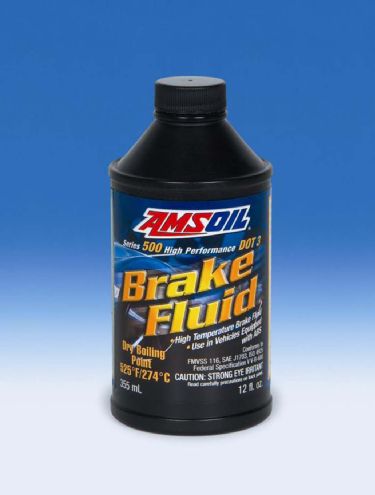 AMSOIL INC. Series 500 High-Performance DOT 3 Brake Fluid and Series 600 High-Performance and Racing DOT 4 Brake Fluid both exceed Federal Motor Vehicle Safety Standard #116 and all requirements of the Department of Transportation (DOT). We used DOT 4.
AMSOIL INC. Series 500 High-Performance DOT 3 Brake Fluid and Series 600 High-Performance and Racing DOT 4 Brake Fluid both exceed Federal Motor Vehicle Safety Standard #116 and all requirements of the Department of Transportation (DOT). We used DOT 4.
The absorption of water has a direct impact on the boiling point of brake fluid so the DOT measures it on two separate scales: the dry equilibrium reflux boiling point (ERBP) is the boiling point of new, freshly opened unused fluid; and the wet ERBP, the boiling point of a brake fluid after it has absorbed 3 percent water. The minimum dry ERBP for DOT 3 brake fluid is no less than 401 degrees F; the minimum wet ERBP is 284 degrees F. It only takes 4 percent water contamination to bring a DOT 3 fluid’s boiling point down to the federal limit. The minimum dry ERBP for DOT 4 brake fluid is 446 degrees F; the minimum wet ERBP is 311 degrees F. The minimum dry ERBP for DOT 5.1 brake fluid is 500 degrees F; the minimum wet ERBP is 356 degrees F.
Another option is DOT 5 silicone brake fluid. Since silicone fluid does not absorb moisture it must be changed more often than glycol-based fluids, as corrosion can be more of a factor with water accumulating in the system rather than being absorbed by the fluid (the boiling point of the fluid can also be lowered dramatically). The primary advantage to using DOT 5 silicone fluid is that it will not harm paint. Also, DOT 3, 4, and 5.1 glycol-based fluids are compatible with each other, but when mixed with DOT 5 silicone a gel-like sludge will develop in the brake system with potentially disastrous results.
Stopping Power
If there’s anything that matches the thrill of being pushed back in the seat from acceleration when you stand on the gas its being held back by the seatbelts when the brake pedal is pushed with the same enthusiasm in a critical situation. With a high-performance car like the ARP/STREET RODDER Ford the “whoa” requires the same consideration as the go.